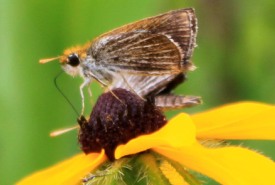
NCC’s Tall Grass Prairie Natural Area protects Canada’s only population of endangered Poweshiek skipperling. (Photo by NCC)
Poweshiek skipperling
The Poweshiek skipperling is a small, brown- and orange-winged butterfly. About the size of a loonie, the insect is so small that it often goes overlooked. But in Manitoba, the Nature Conservancy of Canada (NCC) is paying close attention to this species and its plight in order to ensure its survival.
Life cycle
The adult butterfly is active for approximately three to four weeks, usually from late June to mid- or late July. The female lays eggs on host plants in the tall grass prairie. The eggs hatch in nine to 10 days.
The Poweshiek skipperling goes through seven larval stages. In the first phase, the caterpillars feed on the leaves of the host plant and eventually overwinter near the base of those plants. They then emerge in spring to feed. After pupation, the adult Poweshiek emerges in late June or early July. There is only one generation per year. Adults are often found on black-eyed Susans — their favourite food plants.
Where is it found?
In Canada, this species occurs in southeastern Manitoba’s tall grass prairie, in a limited area near Vita. The closest population in the United States is several hundred kilometres to the southeast, appearing in only a handful of sites in Michigan and Wisconsin.
What is its conservation status?
The Committee on the Status of Endangered Wildlife in Canada has listed the Poweshiek skipperling as endangered. The species is also listed as endangered under the Manitoba Endangered Species Act and considered globally imperilled by NatureServe. The species’ numbers have dropped dramatically in the past few years throughout North America. Fewer than 50 butterflies were observed in Canada in 2015.
What is NCC doing to protect habitat for this species?
In recent years, NCC staff have been closely monitoring Poweshiek numbers, since most of the Canadian population lives on NCC owned or co-managed properties in the Manitoba Tall Grass Prairie Preserve (TGPP). Here are the ways NCC is protecting the Poweshiek:
- Protect and manage the high quality tall-grass prairie that the species depends on.
- Work with cattle farmers to sustainably manage Poweshiek sites.
- Carry out annual surveys of Poweshiek skipperling populations in Manitoba.
- Support the development of a captive rearing program for the species.
- Support researchers examining genetic diversity and threats.
- Carry out research to inform land management decisions using the best available science.
- Contribute to and engage in research to assess how landscape characteristics, land management and weather affect Poweshiek skipperling populations in Manitoba.
- Coordination and engagement in recovery efforts among Canadian and American Poweshiek skipperling conservation agencies and experts.
- Directly supporting student researchers.
- Raising public awareness through Weston Tall Grass Prairie Interpretive Centre displays, an interpretive poster and public presentations.
How you can help
Help protect habitat for prairie species like the Poweshiek skipperling by making a donation to NCC.




